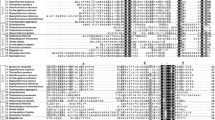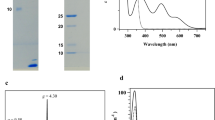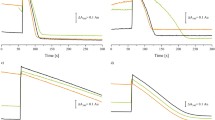Abstract
Superoxide reductase (SOR) is a superoxide detoxification system present in some microorganisms. Its active site consists of an unusual mononuclear iron center with an FeN4S1 coordination which catalyzes the one-electron reduction of superoxide to form hydrogen peroxide. Different classes of SORs have been described depending on the presence of an additional rubredoxin-like, desulforedoxin iron center, whose function has remained unknown until now. In this work, we investigated the mechanism of the reduction of the SOR iron active site using the NADPH:flavodoxin oxidoreductase from Escherichia coli, which was previously shown to efficiently transfer electrons to the Desulfoarculus baarsii SOR. When present, the additional rubredoxin-like iron center could function as an electronic relay between cellular reductases and the iron active site for superoxide reduction. This electron transfer was mainly intermolecular, between the rubredoxin-like iron center of one SOR and the iron active site of another SOR. These data provide the first experimental evidence for a possible role of the rubredoxin-like iron center in the superoxide detoxifying activity of SOR.







Similar content being viewed by others
Notes
The semireduced form of SOR corresponds to the air-isolated protein, where center I is ferric and center II is ferrous.
Abbreviations
- Fpr:
-
NADPH:flavodoxin oxidoreductase
- ROS:
-
Reduced oxygen species
- SOR:
-
Superoxide reductase
- Tris:
-
Tris(hydoxymethyl)aminomethane
References
Winterbourn CCC (2008) Nat Chem Biol 4:278–286
Imlay JA (2008) Annu Rev Biochem 77:755–776
Fridovich I (1995) Annu Rev Biochem 64:97–112
Jenney FE, Verhagen MFJM, Cui X, Adams MWW (1999) Science 286:306–309
Lombard M, Fontecave M, Touati D, Nivière V (2000) J Biol Chem 275:115–121
Nivière V, Fontecave M (2004) J Biol Inorg Chem 9:119–123
Kurtz DM Jr (2006) J Inorg Biochem 100:679–693
Pereira AS, Tavares P, Folgosa F, Almeida RM, Moura I, Moura JJG (2007) Eur J Inorg Chem 18:2569–2581
Pinto AF, Rodrigues JV, Teixeira M (2010) Biochim Biophys Acta 1804:285–297
Wildschut JD, Lang RM, Voordouw JK, Voordouw G (2006) J Bacteriol 188:6253–6260
Coelho A, Matias P, Fülöp V, Thompson A, Gonzalez A, Carrondo MA (1997) J Biol Inorg Chem 2:680–689
Yeh AP, Hu Y, Jenney FE Jr, Adams MWW, Rees DC (2000) Biochemistry 39:2499–2508
Santos-Silva T, Trincao J, Carvalho AL, Bonifacio C, Auchère F, Raleiras P, Moura I, Moura JJG, Romao J (2006) J Biol Inorg Chem 11:548–558
Katona G, Carpentier P, Nivière V, Amara P, Adam V, Ohana J, Tsanov N, Bourgeois D (2007) Science 316:449–453
Tavares P, Ravi N, Moura JJG, Le Gall J, Huang YH, Crouse BR, Johnson MK, Huynh BH, Moura I (1994) J Biol Chem 269:10504–10510
Emerson JP, Cabelli DE, Kurtz DM Jr (2003) Proc Natl Acad Sci USA 100:3802–3807
Nivière V, Asso M, Weill CO, Lombard M, Guigliarelli B, Favaudon V, Houée-Levin C (2004) Biochemistry 43:808–818
Rodrigues JV, Saraiva LM, Abreu IA, Teixeira M, Cabelli DE (2007) J Biol Inorg Chem 12:248–256
Bonnot F, Houée-Levin C, Favaudon V, Nivière V (2010) Biochim Biophys Acta 1804:762–767
Rodrigues JV, Abreu IA, Cabelli D, Teixeira M (2006) Biochemistry 45:9266–9278
Emerson JP, Coulter ED, Cabelli DE, Phillips RS, Kurtz DM Jr (2002) Biochemistry 41:4348–4357
Archer M, Huber R, Tavares P, Moura I, Moura JJ, Carrondo MA, Sieker LC, LeGall J, Romao MJ (1995) J Mol Biol 251:690–702
Emerson JP, Coulter ED, Phillips RS, Kurtz DM Jr (2003) J Biol Chem 278:39662–39668
Rodrigues JV, Abreu IA, Saraiva LM, Teixeira M (2005) Biochem Biophys Res Commun 329:1300–1305
Grunden AM, Jenney FE Jr, Ma K, Ji M, Weinberg MV, Adams MW (2005) Appl Environ Microbiol 71:1522–1530
Auchère F, Sikkink R, Cordas C, Raleiras P, Tavares P, Moura I, Moura JJ (2004) J Biol Inorg Chem 9:839–849
Auchère F, Pauleta SR, Tavares P, Moura I, Moura JJ (2006) J Biol Inorg Chem 11:433–444
Pagen CC, Moser CC, Chen X, Dutton PL (1999) Nature 402:47–52
Clay MD, Jenney FE Jr, Noh HJ, Hagedoom PL, George GN, Adams MWW, Johnson MK (2002) Biochemistry 41:9833–9841
Mathé C, Weill CO, Mattioli TA, Berthomieu C, Houée-Levin C, Tremey E, Nivière V (2007) J Biol Chem 282:22207–22216
Pianzzola MJ, Soubes M, Touati D (1996) J Bacteriol 178:6736–6742
McIver L, Leadbeater C, Campopiano DJ, Baxter RL, Daff SN, Chapman SK, Munro AW (1998) Eur J Biochem 257:577–585
Gray HB, Winkler JR (2003) Q Rev Biophys 36:341–372
Kurtz DM Jr (2007) Dalton Trans 4115–4121
Acknowledgments
We thank Jean-Marc Moulis for providing us with rubredoxin from Clostridium pasteurianum and Vincent Favaudon for kind assistance in pulse radiolysis experiments. V.N. and S.D. acknowledge support from the Agence Nationale de la Recherche, programme Physique et Chimie du Vivant 2008. We thank the language center of René Descartes University and Sam Shen for proofreading the manuscript.
Author information
Authors and Affiliations
Corresponding author
Electronic supplementary material
Below is the link to the electronic supplementary material.
Rights and permissions
About this article
Cite this article
Bonnot, F., Duval, S., Lombard, M. et al. Intermolecular electron transfer in two-iron superoxide reductase: a putative role for the desulforedoxin center as an electron donor to the iron active site. J Biol Inorg Chem 16, 889–898 (2011). https://doi.org/10.1007/s00775-011-0788-5
Received:
Accepted:
Published:
Issue Date:
DOI: https://doi.org/10.1007/s00775-011-0788-5




